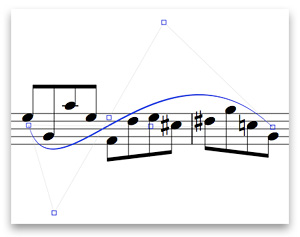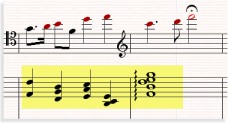Composing and arranging in Sibelius
You just think of the notes – Sibelius does the rest
Sketch & refine
Sibelius lets you change music whenever you like. Sketch a solo flute piece, then add a whole orchestra to create a concerto. Write in sounding pitch, then make a transposing score with one click. Add extra bars at the start of a score, and Sibelius instantly reformats every page – far more flexible than pen and paper.
If you completely change your mind, Sibelius lets you undo up to 20,000 operations, and keeps backups of 40 previous versions of your music.
Text & lyrics
Sibelius puts different types of text, such as dynamics, titles and lyrics, in the appropriate font, size and position. You can edit these text styles to change text consistently throughout the score.
To input lyrics, just type – Sibelius positions the words under the notes, puts in hyphens and lyric lines, and allows extra room for long syllables. You can also copy lyrics from a word processor.
To save typing all the lyrics into a score, you can now add them automatically from a text file - Sibelius even splits them into syllables for you. Or if you type the lyrics in yourself, Sibelius will check that you’ve split syllables in all the right places.
![]() Watch movie: Text & Lyrics »
Watch movie: Text & Lyrics »
Cautionary accidentals
Sibelius now adds cautionary accidentals all by itself wherever they’re needed, so you’ll get fewer wrong notes in performance. It should do just what you want by default, but as usual we’ve included various options you can tweak: these include where to use cautionary accidentals (e.g. up to the end of the next bar, between different octaves or voices, or when tying notes between systems), and whether to draw them in parentheses.
Comments
Comments are like Post-It™ notes you can add to your score. And just like the real thing, you can use them to write reminders to yourself, or to communicate with someone else you’ll be sending your score to.
To create a comment, just click the new toolbar button, then type – it automatically includes your name, the date and time. Add a comment to a selected passage, and it will also state the instrument(s) and bars referred to.
You can change the appearance of comments, and ones written by different people are automatically color-coded – ideal if you’re sharing a score with a student, teacher, arranger or editor.
Arrange™
Arrange is a unique feature to help with arranging and orchestration. It’s ideal for students learning instrumental writing, and saves hours of time for experienced professionals.
Just select some music, and specify how you want it to be arranged or orchestrated – Sibelius does the rest in an instant, using appropriate instruments, doublings, etc. It handles anything from keyboard reductions and ‘exploding’ chords onto separate staves, to sophisticated arrangement and orchestration styles, such as:
- Band, using high brass and pitched percussion
- Choir, tenor doubling soprano down an octave
- Jazz, in the style of famous band leaders including Sammy Nestico, Billy Strayhorn and Thad Jones
- Impressionist orchestration with harp and strings.
Over 150 of these styles are provided, and you can even create your own.
Slurs
Sibelius now has the most beautiful and controllable slurs of any program. Not only is their default design and position even better in all kinds of situations, but you can adjust their shape using no fewer than six handles, and alter their thickness individually.
New Engraving Rules options also let you control the default height and shoulder for different slur lengths. Sibelius makes it easy to write large scores, by allowing you to view just the staves you're working on.
Focus on staves
Sibelius makes it easy to write large scores, by allowing you to view just the staves you're working on.
Repeat bars
You can now add 1-, 2- and 4-bar repeats from the Keypad, which now play back just like anything else. Multiple repeat bars can also be automatically numbered (without using a plug-in), so performers won’t lose their place.

Copying & transposing
Copying music is far faster than re-writing it, so Sibelius copies anything with one click of the mouse – especially useful for doubled instruments and repeating figures. You can make multiple copies at once, e.g. to put the same dynamics onto every instrument.
Sibelius transposes music instantly into any key, and handles everything about transposing instruments for you. Write music in sounding or written pitch, and switch between the two whenever you like.
![]() Watch movie: Copying & repeating »
Watch movie: Copying & repeating »
Unplayable notes shown in bright red, difficult
notes in dark red |
Checking for mistakesSibelius saves you time by spotting all kinds of mistakes such as rhythms that don’t add up, or notes that are too high/low to play (see picture). Sibelius knows every instrument’s range, which you can adjust for players of different abilities. Sibelius comes with various proof-reading plug-ins (read more), including ones which add cautionary accidentals and even mark parallel fifths and octaves! |
Quick links
Sibelius features »
What's new »
Sibelius FAQ »
Education case studies »
Download demo »
Buy/upgrade »
Take a tour
A comprehensive guide to Sibelius's features


